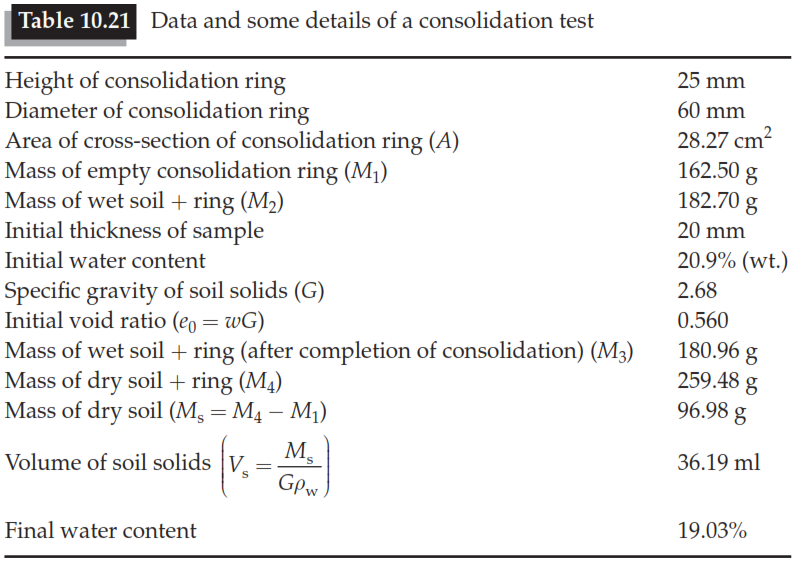Consolidation test on soil | Scope | Procedure
Scope
To determine the consolidation test on soil
Equipment
Reinforcement ring – A leading edge is provided to facilitate the fabrication of a rigid ring and patterns with a swish and polished inner surface.
However, The minimum diameter of the ring ought to be sixty millimeters and also the diameter-height magnitude relation is three. (Figure 10.16)

Porous stone – carbide, corundum, or alternative porous material with high consistency, which suggests free voidance throughout the take a look at is secured.
Moreover, The porous stone diameter is zero.2 to 0.5 millimeters but the inner diameter of the ring. the dimensions of the stone vary reckoning on the sort of ring (Figure 10.16)
Reinforcement Cell – A instrumentality for holding a reinforcement ring is water holding and permits to live the modification within the height of the specimen on the dial gauge of its central axis – with a travel length of fifty of the sample height
Loader – capable of taking axial hundreds in best increments with the acceptable lever magnitude relation and maintaining it for giant periods with an appropriate modification of Application 1 Chronicles of the applied load (Fig. 10.17).
There ought to be no important result throughout the loan application. It should be settled in a vicinity free from vibrations Sample Extruder Trimming Tool Tools for determinant water content
Procedure:
1. notice the mass of the empty reinforcement ring (M1).
2. Coat the inner surface with siloxane grease or oil. rigorously trim the pattern to match the reinforcement ring and weigh the mass on the ring (M2). Keep a little quantity of soil from trimmings to see the water content.
3. Record the thickness of the specimen. If you’re having to bother measuring the thickness, take the thickness of the ring because of the initial thickness.
4. reckoning on the sort of ring (fixed or floating), choose the proper size of porous stone. Center the ring and pattern on the saturated bottom porous stone and place the saturated porous stone on high, then place the loading cap.
5. Place the consolidometer into the loading device and fix the dial gauge. Fill the Consolidometer with water, apply a five kN / M2 seat load and permit it to succeed in a wetness balance in twenty-four hours.
6. Therefore, Apply the primary load increment and at the same time take deformation readings of zero.25, 0.50, 1, 2, 4, 8, 15, 30, and hour and a couple of, 4, 8, and twenty-four hours.
7. However, Apply the increment load when twenty-four hours, taking into consideration the very fact that the pressure applied at any loading purpose ought to be over double that of the previous step. Apply the subsequent loading sequence: 10, 20, 40, 80, 160, 320 kN / M2. Repeat step half-dozen anytime.
8. Once the ultimate loading is complete, lower the sample with a pressure drop that reduces the load to a simple fraction of the previous load.
Take dial gauge readings at every stage of unloading. If desired, identical intervals adopted throughout loading could also be adopted.
Therefore, Keep the last unloading at five kN / M2 pressure for twenty-four hours to cut back swelling throughout the activity.
9. take away the ring, wipe the water on the surface of the ring and notice the mass (M3).
10. when drying, weigh the specimen with the ring and notice the mass (M4).
Computations
(a) Coefficient of consolidation;
Plot dial gauge reading versus t or versus log t for each load increment, and find the coefficient of consolidation from the following expressions.
where Hav is the average thickness of the specimen for that load increment.
(b) Coefficient of compressibility
The equivalent height, Hs = Vs / A
where A is that the space of the specimen.
The void magnitude relation e, at the tip of every pressure increment, is given as
where H is that the height of the specimen at the tip of every pressure increment. The coefficient of sponginess Av, with units inverse of these for stress, is given as
(c) Compression index Cc
Plot the void magnitude relation e versus log p.
However, The slope of the straight-line portion of the curve is that the compression index Cc that is given as
where p2 and p1 are the consecutive values of pressure and Δe is that the amendment within the void magnitude relation over the on top of vary of pressures.
Results
The consolidation check results are given within the sort of the subsequent curves:
1. e versus log p
2. Dial reading versus log t for various stress ranges
3. Dial reading versus t for various stress ranges
4. Av versus log p
5. cv versus log p
Since Some typical check results are given in Tables 10.21 to 10.23, and also the corresponding plots are given in Figs. 10.18 and 10.19.
Discussion
As the effects of sample preparation are identical for any size of the sample, larger samples provided
more reliable results.
However, The floating ring reduces the resistance loss on the perimeters of the sample between the soil and ring, and hence, the check rate is concerning fourfold quicker.
Moreover, The fixed ring has the advantage of measuring the k worth of the sample because it is tested.
The curve fitting ways are mentioned in Chapter six. different details of the check may be obtained from IS 2720– half fifteen (1986).
Video:
Also Read:









